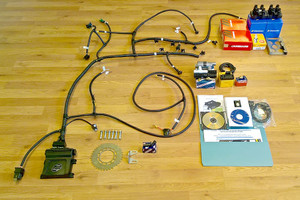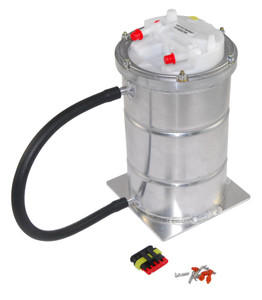
14 CUX Tornado Chip 4.0 TVR / Morgan / RV8
TornadoWhat do I get? You are buying updated software to install into a Lucas 14CUX “Hotwire” Fuel Injection computer. The software is supplied in an EPROM chip with the necessary decoder board, all packed in an anti-static shipping box. These parts are shown in the picture at the top of this listing. Fitting instructions are supplied, with full colour photographs. This software is intended for the 4.0 Litre engine, where the car is still using the standard Lucas 5AM airflow meter and standard Land Rover ERR722 fuel injectors. For best results the fuel pressure should be set to the standard 2.5 Bar, since the fuel injectors are operating within their maximum flow capacity. What are the benefits? Even for a sports car manufacturer, exhaust emissions is the first priority that must be met when mapping the standard engine. This inevitably involves various compromises to be made over the ideal settings for economy or power. Manufacturer’s emission tests are very much more stringent than the MOT test, and include the warm-up cycle which is where most of the problem emissions occur. Emissions compliance requires a very flat air/fuel mixture, which is neither ideal for economy or power. The compromises in the fuelling also require very conservative ignition timing. Once the fuelling issues are addressed then more adventurous ignition timing may be used. Such characteristics are not unique to any fuel injection system or vehicle manufacturer. This behaviour is displayed by most modern cars, which have to comply with very tough exhaust emission legislation as the first priority. Emission standards for manufacturers are so demanding that they need to use every trick in the book to ensure compliance. It is possible to achieve 10-15 BHP power increases with 10-15% economy improvements once these compromises are removed, and the engine will rev much more smoothly and eagerly. Many other operating characteristics are addressed by this upgrade. These include idle speed, idle stability, cold starting, crank fuelling, rev limit, etc. Therefore this is a thorough treatment of the entire set of operating characteristics that goes far beyond ignition or fuelling adjustments.
The standard fuel map only goes up to 5500 RPM which is fine for a standard Land Rover Discovery or Range Rover, but is not best suited to the more sporting variants. Where appropriate the map is extended to 6000-6500 RPM as determined by the application. As you would expect, the upgrades are fully compatible with the standard Land Rover vehicle diagnostic and security systems. Service and fault diagnosis procedures are unaltered, and the upgrade is undetectable to Land Rover TestBook, Autologic, Rovacom or Lucas/Sun PDL test equipment. Important Notes There are two families of Lucas 14CUX ECUs. Before you place your order we need to check which type you have, so please contact us first. All original TVR supplied ECUs have “plug-in” chips, with the appropriate socket fitted. If the ECU is not original (e.g. replaced by a Land Rover standard version to fix a fault) then it may not have a socket, so in this case it will be necessary to have a socket fitted to receive the new chip. We can arrange this for you at a small cost, but again it is essential that you contact us first.
Because all these engines are hand-built, there is some considerable variation between similar examples. The settings used in this software are based on examples taken from dyno testing more than 2,500 Rover V8 engines over sixteen years. Occasionally there are engines that fall outside this range, so if there is any odd behaviour observed after installing the software then it is important that you get in contact straight away. Special versions of the software can be produced to take account of these variations.
Maximum benefits will only be seen where there are no underlying problems or faults with the engine. It is always recommended that you have the vehicle checked by a specialist. We can also tailor the software to an individual car and owner at our four wheel drive rolling road facilities at Cheltenham or Gatwick. Note that there are separate charges for this service.
Fuel injector problems are very common with the standard Lucas parts, and we recommend that they should be ultrasonically cleaned and tested. Technical Details Fuel supplied during engine cranking is very generous (to say the least), so this has been decreased to reduce the risk of flooding. A small starting delay (approximately 2-3 engine revolutions) has been introduced to allow oil pressure to build up before starting. Engine temperature map fuel compensation map features decreased cold and warm up fuelling to reduce the risk of flooding. The engine’s fuel requirements are determined by engine speed and load. Engine load is determined by measuring the true mass of air that the engine is consuming at any particular speed, using the “hotwire” airflow meter. Mass airflow is proportional to the torque that the engine is producing, and hence it is closely related to the engine capacity. This is also heavily influenced by atmospheric conditions such as barometric pressure, temperature, etc.
Therefore it is vital that the software is programmed with the correct maximum mass air consumption of the engine, known as airflow meter scaling. This is vital for good driveability and fuel economy especially on large capacity engines, and allows correct control of part throttle fuelling. Note that airflow meter scaling determines when the top of the fuel map is reached. When using an engine of larger capacity than the software was designed for, the top of the map will be reached too soon. This leads to over-fuelling at part throttle, and under-fuelling at full throttle. A re-profiled Fuel Map which provides good fuel economy on part throttle, and allows engine to rev more freely (standard profile reduces fuelling heavily after 4000RPM). This produces quicker, more progressive throttle response and better mid range torque. Fuel map range is extended from the current 5500 RPM upper limit, to 6000-6500 RPM where appropriate. Idle speed is lifted to give smoother idle. For automatics this allows a smaller differential between Neutral/In-gear idle speeds, thereby reducing transmission “clunk” when selecting gear. The idle speed control system also determines the amount of engine braking, and this has also been revised to provide a small but useful increase in this property. The software limits road speed to standard 113 MPH, which is removed (although not applicable to TVRs). “Check Engine” (or MIL) lamp is enabled when any fault codes are present in the ECU, although the wiring in earlier TVRs will still stop it working! This lamp is disabled in the software for all territories except North American Specification (NAS) vehicles.





